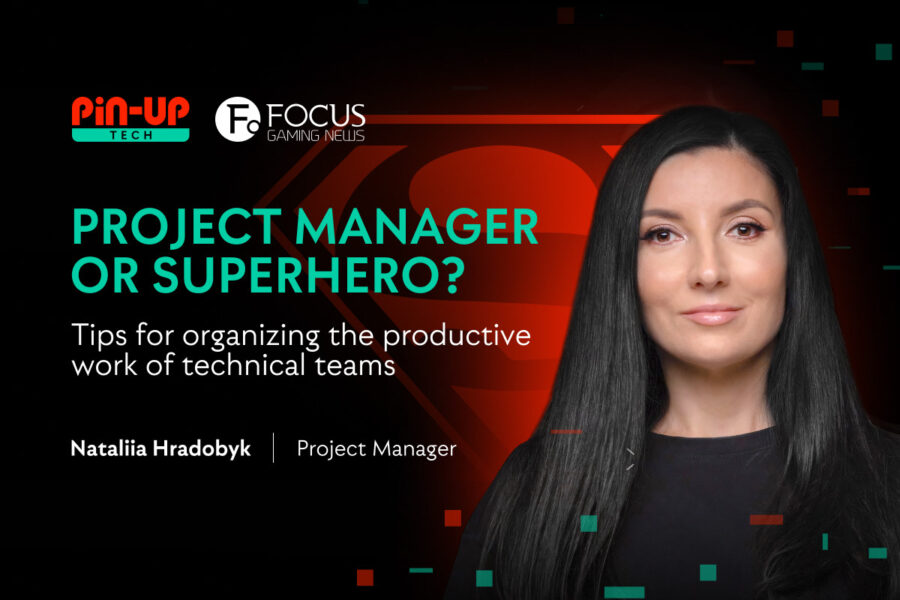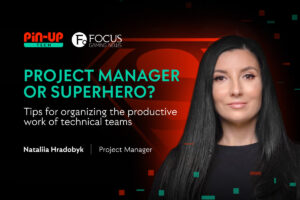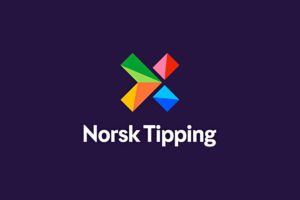Project manager or superhero? PIN-UP.TECH shares tips for organizing the effective work of technical teams

Nataliia Hradobyk, Tech Project Manager at PIN-UP.TECH, shares tips for building and organizing workflows for technical projects, emphasizing communication and understanding of the technical context.
Opinion.- Technical project managers are the people who build and organize the process of developing a technical project or initiative. They deal with requests, required competencies, responsible persons, and task prioritization. Nataliia Hradobyk, tech project manager at PIN-UP.TECH, tells how to become a project manager who has everything under control.
Peculiarities of organizing the work of technical teams
To understand the context, I will explain that there are two types of project managers at PIN-UP: classical and technical. Classical project managers have their own teams and human resources at their disposal, while technical project managers act as organizers and coordinators of the process of developing technical initiatives and projects.
Tech PMs coordinate them during the Pre-Project phase, facilitate communication between all stakeholders at the Initiation and Planning stages, and during the Execution and Control stages, they form and manage a temporary virtual team or transfer the scope of work to the Domain team.
Technical initiatives of PIN-UP.TECH are usually aimed at solving platform, infrastructure, CI/CD issues, or at requests from internal departments such as Security, DevOps, Infra, HR, etc. For a technical project manager, it is important to have in-depth knowledge not only of PM approaches, but also of technologies to understand the project context, effectively facilitate communication, and help identify possible technical risks.
The main task of a technical Project Manager is to effectively coordinate specialists from different teams and departments working on a common goal. This means setting up workflows from scratch for each request or project, balancing between different virtual teams and their team member’s parallel activities, finding suitable time slots for meetings, and even “fighting” with constantly competing priorities.
Tech PM tips for effective workflow organization
To build the workflow correctly and without unnecessary stress, I have a few tips for you:
- Continuous training in domain and technology: It is important to understand all the specific terminology to communicate with the team in the same language. It is also equally important for helping the team build a well-developed backlog.
- Effective facilitation: It is not necessary to be an expert in all the technical details, your goal is to coordinate communication between the Technical SMEs and the implementers. Record videos of important meetings, take structured and insightful meeting notes and use Miro boards for facilitation.
- Gathering technical requirements: Gather working groups for requirements brainstorming, record ideas on Miro, and validate them with the team. Identify a responsible Technical SME to formalize the requirements into a document.
- Regular team syncs: Even if you don’t work according to Scrum, hold daily Scrum events to identify blockers and dependencies in your work in time.
- Writing technical tasks with clear Acceptance criteria: This helps the team to clearly understand what needs to be done within the task and make sure that everyone understands the task scopes equally.
- Building a buffer in the planning: Take into account the possibility of critical tasks from the business, which almost always have a higher priority.
Tools and approaches to facilitate PM’s work
- Miro and visual facilitation: Create templates for meetings in Miro according to your agendas, which will help you not to miss important and scheduled items and set the team up for productive dialogue.
- Facilitate the conversion of discussions into Action Items: If the team discusses the need to perform a certain activity/task, immediately help them identify the person in charge, the deadline, and specific actions/results so that conversations don’t remain just that, conversations. Conduct regular action items review.
- ChatGPT: Use it to structure call-ups and meeting notes, level up your emails, brainstorm risks, train new technologies, analyze technical resumes, etc.
- BigPicture plug-in in Jira: For planning and visualizing project progress.
Where to get the knowledge
● Google Project Management Certification: Practical tools for working with projects at all stages of the life cycle. Best practices for working with risks, stakeholder management, and creating a project plan.
● Agile Estimating and Planning by Mike Cohn: Here you will get answers to all questions about estimating in Story Points.
● Facilitator’s Guide to Participatory Decision-Making by Lenny Lind and Sam Kaner: Techniques and life hacks for effective group facilitation. You will understand what group dynamics are and how you can influence them.
● Actionable Agile Metrics for Predictability by Daniel S. Vacanti: A book about flow metrics for process improvement. For me, it’s a must-read! One of the best books in recent times.
● AI for Everyone course: Artificial intelligence basics for everyone. After this course, you will understand how to work with ChatGPT and reach a new level in writing prompts.
● This is Lean by Niklas Modig and Pär Åhlström: Practical examples for understanding the Lean approach and implementing it to improve the efficiency of your processes.
It is worth remembering …
To be a productive project manager in tech, it is equally important to be familiar with the technologies that businesses implement and use, understand the principles of organizing and coordinating work processes, and constantly improve your communication skills. And, of course, as in any other profession, a true project management guru is someone who is always trying to learn something new, expand their expertise, and optimize and improve their usual processes.
Nataliia Hradobyk — Project manager / Certified Scrum Master with 10+ years in IT, 5+ years leading Agile Teams, and active Agile community speaker.











